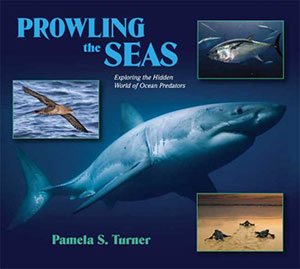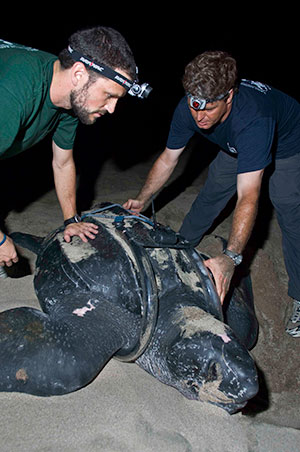Prowling the Seas: Exploring the Hidden World of Ocean Predators
“Students of marine life and its conservation, as well as budding oceanographers, will find this title illuminating.”
— School Library Journal

About the Book
One racing turtle…
One traveling tuna…
One vacationing shark…
Two wandering seabirds…
And one big ocean.
Tag along!
Most of the world’s great predators don’t live on the plains of Africa or the jungles of India. Their home is the vast blue ocean. For many years scientists have longed to know more about ocean predators. Where do they go? How do they find food? The dedicated scientists of the Tagging of Pacific Predators (TOPP) project use high-tech tags to follow ocean wildlife swimming in the down in the deep or flying high above the waves, revealing the secrets of these fascinating animals and their remarkable hidden world.
Awards and Recognition
- Cybils Nonfiction nominee
Reviews
School Library Journal:
“In 2000, a multinational group of scientists created the Tagging of Pacific Predators project (TOPP) to study the dwindling numbers of ocean predators and find ways to save them. This book reports on the work of scientists who fitted four species with satellite tags—loggerhead turtles, great white sharks, bluefin tuna, and sooty shearwater seabirds. The succinct text describes where the animals were found, how they were tagged, and what information the scientists gleaned as they traced migration routes, located feeding and breeding grounds, recorded the distances traveled and the length of time it took, and so on. Some basic facts about the creatures are incorporated as well, such as outstanding physical and behavioral characteristics, senses, and diet. The chapter on loggerhead turtles also describes a “race” between 11 female turtles to see which one reached the Galapagos Islands first after laying eggs in Costa Rica. One or two sharp color photographs or illustrations appear on every page; they depict the animals (the underwater shots of sharks are particularly good) and some of the scientists involved in the project. A map of the Pacific, with colored silhouettes of the animals and lines indicating their travel routes, appears at the end of each chapter. An addendum cites the current estimated population figures for the predators discussed. Students of marine life and its conservation, as well as budding oceanographers, will find this title illuminating.”

Walker Books, 2009
hardcover ISBN 978–0802797483
or used bookseller.


